The Bottle to Sippy Cup Transition
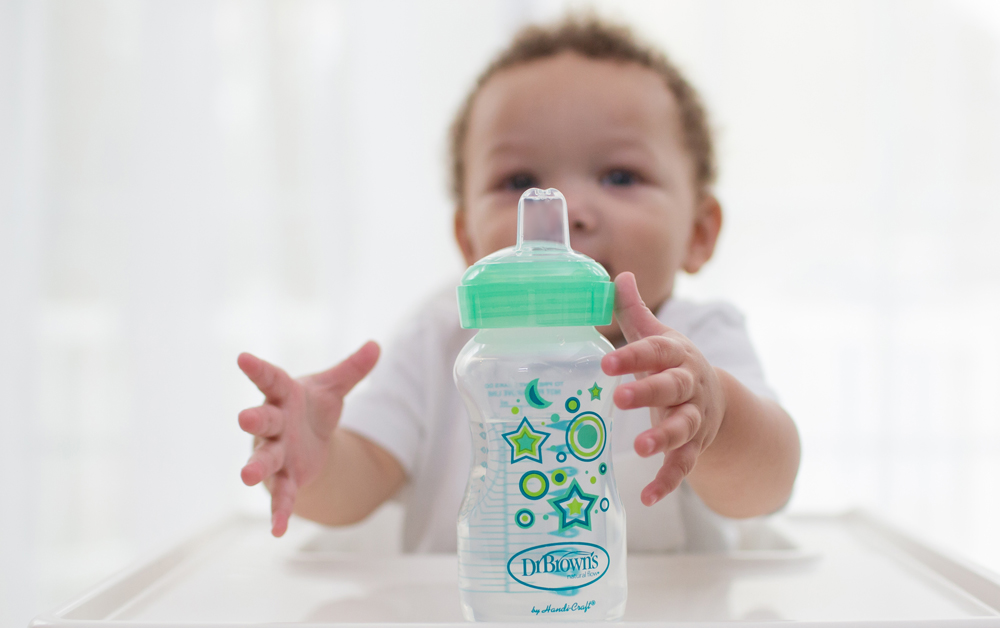
Weaning off bottles signals not just the end of an era (when did your newborn all of a sudden become a toddler?), but it can also be quite a challenge.
I’m in the thick of this right now with my youngest, Mary (~18 months). Last week, she defiantly shrieked “no” to four separate cups I offered her before proceeding to swat each one, in turn, off the table in a fit of fury.
So I’d say it’s going well – HA.
I know I’m not alone in this since many of you have recently asked about how to make the transition from bottles to sippy cups.
Most authorities, including the American Academy of Pediatrics and the dentists we spoke with, recommend that parents wean babies off bottles by around 12-18 months. That said, you shouldn’t lose sleep over it; in fact, it’s way more important to limit sugar intake and brush your kiddo’s teeth. But when in doubt, it’s best to do it sooner rather than later.
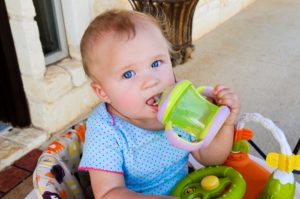
Whether you’re fast approaching the recommended transition time of 12-18 months or (like me) you’re well past it, this article goes over the steps you can take to make the transition from bottle to sippy cup relatively painless, and then discusses in more detail why bottle-weaning matters, for those of you who are interested.
Ready for the bottle to sippy cup transition?
Most professionals would advise you to introduce your child to a sippy cup starting around 8-10 months with the intent that she’ll become used to it around her first birthday. This timing is a bit of a sweet spot because the longer your child has access to her bottle… the more attached to it she’ll grow. You can still make the switch beyond 12 months (obviously), but it will probably become harder the longer you wait.
Preemptively, phasing in sippy cups over time is great advice, but it may not work for everyone; it certainly didn’t work for me. (Cue my screaming daughter. Sigh.)
If you’ve ceremoniously passed the one-year marker and still have bottles at the ready, there are two main approaches:
Whichever route you take, know at the outset that this transition might be easy-peasy (good for you!) or feel like WWIII (I feel you, really). If your efforts to make the transition to a sippy cup feel like a #fail, know this: like so many challenges in baby- and toddlerhood, this too shall pass.
Quitting Bottles Cold Turkey
Tons of parents have told us this worked really well for them — after an admittedly tough two to three days, that is. Some of you even reported literally getting rid of your bottles so you couldn’t cave in and offer one. The same tactic can be used for pacifiers.

Worried about your little one not getting enough liquid? Pediatricians agree: your child will be fine without milk for a few (or several) days. She needs to be hydrated, obviously, but if her milk intake plummets during this time of transition, it’s not a cause for concern.
The overall idea here is that eventually, your child will grasp that if she wants any milk, she has to drink from the cup. This tack might entail more dramatic outbursts but generally seems to work pretty quickly (within a couple days — kind of like the two-day method of potty training).
The Gradual Transition
Other families might prefer a gradual shift — the advantage here is that you’re likely to weather fewer tantrums, but it takes longer.
Parents who have followed this method recommend weaning the middle-of-the-day bottles first (replacing them with a cup) and gradually branching out to wean off other bottles, with the nighttime one being the final rung.
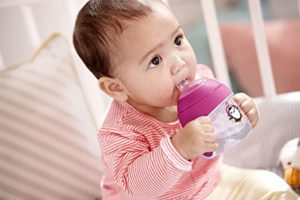
Other Suggestions
Whichever path you choose, here are some other tips and tricks for making the switch smoother:
- Don’t let your child carry her bottle around — it might increase her attachment to it. Instead, make bottle feedings true “feedings” with a clear beginning and end.
- Don’t let your baby take her bottle (or sippy cup!) to bed.
- If your child is over 18 months old, you can tell her what’s going on and explain that you’re switching to “big kid” cups permanently. In other words, communication is key.
- Many parents tell us that using small amounts of juice for a few days helped them make this switch more enticing for babes (we know, we know, we’re not supposed to give our kids juice, but it’s a temporary strategic tactic for the greater good here!)
- Some parents also say that only offering water in a bottle, and milk in the cup, helped make the cup more appealing.
Best Sippy Cups for Weaning off the Bottle
Our comprehensive Sippy Cup Smackdown covers all your best sippy cup options, but there are a few noteworthy standouts when it comes to weaning off the bottle:
NUK Learner Sippy Cup ~$8 — Parent Pick
You might have better luck initially with a soft spout that will feel more like a bottle nipple than a hard-spouted cup. Parents rave about these!
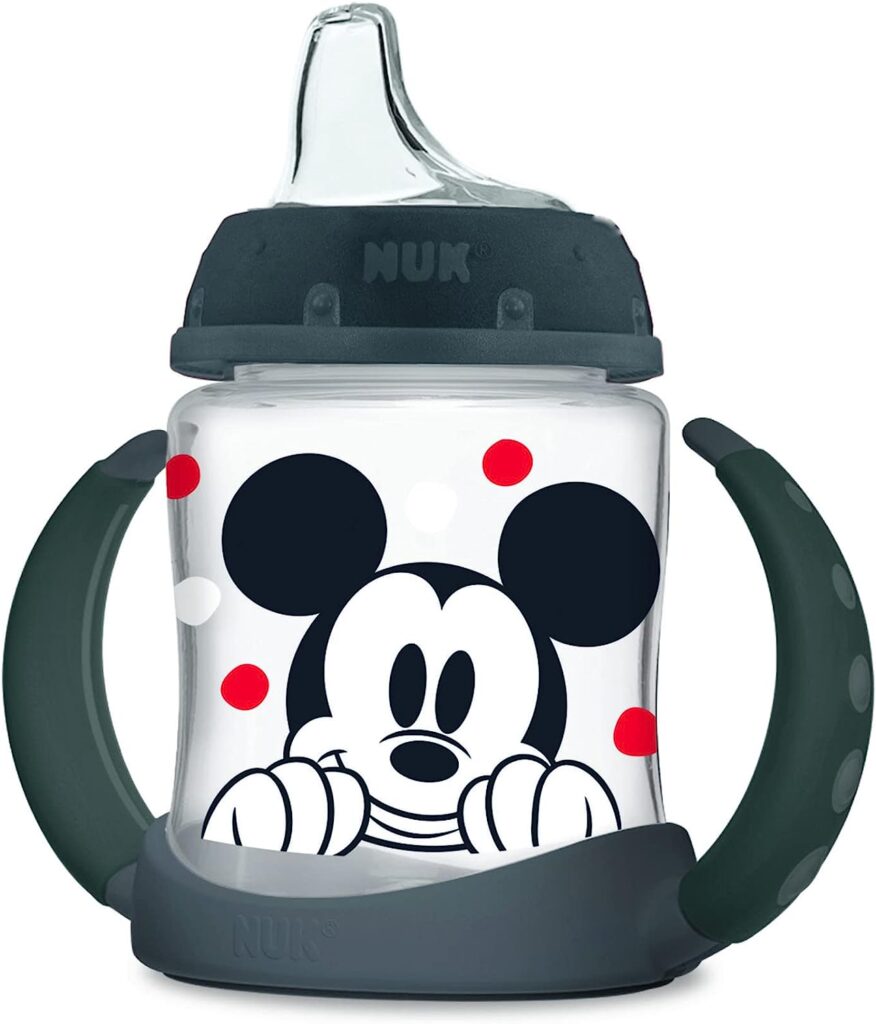

Nuby No-Spill Super Spout Easy Grip Cups ~$9 for a 2-pack — Runner-Up
Another solid choice for the same reason; a soft, nipple-like spout.
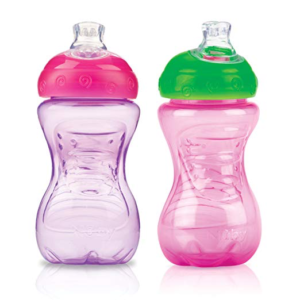

Many bottle brands make a transition sippy cup, so you could always check out your particular bottle brand’s product (especially if your baby is super particular), whether it be Philips Avent My Natural Trainer Cups, Playtex Sipsters, or Dr. Brown’s Soft-Spout Transition Bottles. Some companies even offer just the sippy nipples, which you can use in place of your traditional bottle nipples, for a smooth transition from one step to the next.
Munchkin 360 cups ~$13 for 2
Professionals’ choice: Dentists suggest switching to cups for best oral development.
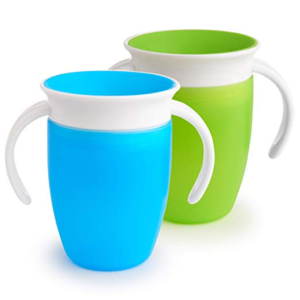

Dentists stress that the ONLY beverage you should offer your child from a sippy cup is water (or milk at a meal). Unless you’re dealing with a specific health issue, such as constipation, even watered-down juice is not recommended. Even though it’s what used to be normal… it’s really not good.
As usual, every child is different, so how and when you’ll make the transition will vary from kid to kid. I had totally different experiences with my two: my son took up a Munchkin sippy cup when he was about 15 months and never had any problems letting go of his bottle; my daughter, on the other hand, has been clinging to hers (both literally and metaphorically) with impressive strength and outlandish tantrums.
To recap: We think it’s reasonable to think about making the big switch from bottles from sippy cups as close to one year as you can. But if you feel like you need more time, don’t sweat it: no matter what you decide on doing, your kid’s not going to college with a bottle (well, not this kind of bottle at least).
Why Bottle-Weaning Matters
Now — if you’re curious about the reasoning behind all this, here’s why bottle-weaning matters in the first place:
Medical and dental professionals have some concerns about babies drinking from bottles for “too long” — their worries stem from:
Risk of Cavities
The American Academy of Pediatric Dentistry states there’s no good evidence indicating a strong relationship between prolonged bottle use and cavities.
Instead, the link between cavities and bottle feeding has more to do with what’s actually in the bottle and your little one’s bottle-feeding habits. Thus, when it comes to cavity prevention, what your baby is eating and drinking and how you care for her teeth are way more significant than her drinking vessel of choice.
Indeed, sugar is everywhere; it exists naturally in milk, formula, and breast milk, which means that all babies have exposure. This especially becomes an issue when babies (with teeth!) take bottles right before bedtime, after brushing their teeth, or even take bottles into bed with them, because they go to sleep with sugar all over their teeth. If you brush teeth before bedtime, this helps alleviate that problem.
Some studies from Japan actually cite a link between prolonged breastfeeding and cavities, rather than prolonged bottle-feeding… and I don’t expect we’ll be hearing any pediatricians or dentists freaking out about this.
So knowing this, you’re better off working on proper dental care than killing yourself trying to transition to a sippy cup by a certain deadline.
Overconsumption of Milk
First, what’s “normal” milk consumption for a toddler anyways?
The long answer involves a big “we don’t know.” Our current views on milk have been powerfully shaped by American cultural and historical context, as well as national nutritional policies and changing medical advice (if you’re interested in the backstory on how and why cow’s milk became the holy grail of childhood nutrition, I’ve written more about that here).
Contrary to traditional (American) belief, the truth is, there’s nothing normal or “magical” about milk as a staple health food. Children and adults alike don’t actually need milk — like, at all — and more and more pediatricians are in fact saying that babies over 1 year old can wean off milk altogether. Many of us know milk as a good, easy source of calcium, and it is — but your kids can get calcium from lots of different foodstuffs. Did you know broccoli and lentils, for example, have more calcium than milk? (The Institute of Medicine recommends 700 mg of calcium daily for 1-3 year olds. Milk can be an efficient way to hit that target, but it doesn’t have to be the default delivery system (and in fact there are several reasons milk shouldn’t be your child’s only source of calcium). For reference, here’s a list of other good sources of calcium for your child.)
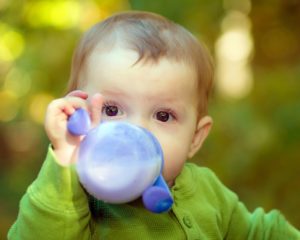
If your toddler likes milk, though, the AAP only recommends about 2 servings of milk per day — that’s 16 ounces. (The American Academy of Family Physicians allows for 2 or 3 cups, or 16-24 ounces.)
This is important to know because most babies taking a bottle can down 6-8 ounces in a sitting, and might drink up to 5 (or more) bottles per day. Case in point: when I started researching for this article, my 18-month-old was guzzling 5 (sometimes 6, gulp) bottles per day… roughly 30-36 ounces daily. Yikes.
People tend to feel really strongly about milk, and we respect that. But whether you’re all for milk or you’re wary of its health benefits, like anything, moderation is best. And since toddlers drinking from bottles are simply more likely to consume (too much) milk, there are underlying concerns that they either:
a) don’t consume enough solid foods (because they’re already full from milk), and therefore aren’t taking in as many and varied nutrients as they normally would. Much of this comes in the form of anecdotal evidence, but the most well-documented piece here has to do with the risk of iron-deficiency (with or without anemia). Studies show that the longer a baby uses a bottle, the higher his risk of developing iron-deficiency. As with the cavities issue, though, this association isn’t about the bottle — it’s about milk consumption. Toddlers who consume more than 24 ounces of milk daily are considered at an increased risk for iron deficiency… and it just so happens that children are more likely to meet that threshold if they’re still guzzling bottles of milk.
or…
b) take in too many overall calories, since they are typically drinking more milk than they need and taking in solids. A study released in The Journal of Pediatrics in 2011 made a huge splash when it linked prolonged bottle use to childhood obesity. The authors reported that children who still used a bottle at 24 months were more likely to be obese at 5.5 years old (roughly 30%) compared to children who’d stopped using a bottle by 24 months (about 16%). The authors hypothesized that children who drink milk from bottles are likely to exceed their nutritional needs on a daily basis, and that overconsumption could play a role in childhood obesity. They also suggested that encouraging parents to wean babies around a year could potentially be one strategy to help prevent childhood obesity.
The evidence on these woes isn’t foolproof by any means, but they are things to consider.
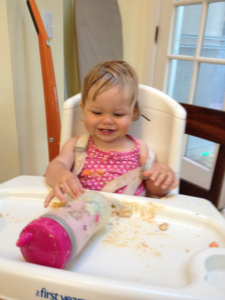
Aside from these two concerns, I also think that babies who favor milk over solids are probably missing out on a key window of opportunity for becoming accustomed to eating solids, learning about new foods, and “getting” how mealtime works. Since the couple years after babies start solids are SO important for exposure to new foods and textures, this seems like a major loss.
Again, the issue is not about the bottle, per se — it’s about the milk. But since bottles are specifically designed to facilitate quick, easy consumption of either formula or breast milk, it’s easy to see how bottle drinkers could end up ingesting more milk, which could in turn impact their solids consumption. (See also: The Toddler Feeding Guide.)
We’ve said it before, we’ll say it again: our dentist experts all agreed that milk consumption for children over the age of one should be limited to mealtimes.
Improper Dental Development
Dentists worry that prolonged bottle and pacifier use can impact teeth positioning and the development of a child’s palate. That’s because prolonged sucking can cause teeth to become misaligned and can lead to “maxillary constriction,” in which the upper arch in a child’s mouth narrows due to the pressure from sucking. (This problem can be corrected with an expansion appliance sometime during childhood or adolescence, so it’s nice to know that there is a solution available, but obviously avoiding the problem altogether would be preferable and cheaper.)
Dr. DeLeon explains that this concern is especially linked to extensive non-nutritive sucking (such as a pacifier). She also reminds us that this is not something to worry about if you’re still breastfeeding — it’s only associated with artificial nipples.
This is also more of a problem with around-the-clock sucking. So even if you were to use bottles past the recommended time frame of 12 to 18 months, the risk of developing dental problems is much smaller if you limit bottle access to meal time.
A note on sippy cups
Strangely enough, prolonged use of sippy cups is also a “thing.” (Don’t we have enough to worry about?!)
Some of the concerns about bottles also apply to sippy cups, and the most important element here (again) is… you guessed it: sugar. “The major concern with sippy cups is what you put in them,” says Marlina Shah (DDS, MS). The dentists we spoke with recommend only offering babies and toddlers water in their sippy cups, and limiting milk-drinking to mealtimes, at the table (ideally, from an open-topped cup). Babies who drink milk all day long are at a higher risk of cavities because their teeth are so frequently exposed to sugars and carbohydrates.
Pro tip: Even though we take the ability to drink from a cup as a given, remember that it really is a skill our children need time to learn. Dr. DeLeon suggests using shot glasses with your toddler at the table to practice drinking from an open-top cup. Stainless steel or plastic shot glasses are the perfect size for babies to grip and sip, and won’t make a huge mess if (ahem, when) they spill. We happened to have this Stanley travel set, and it worked well.
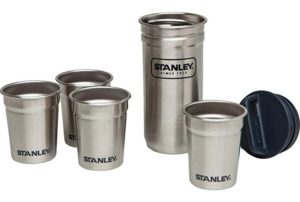

On the plus side, unless a child has a sippy cup in his mouth all the time, other dental effects aren’t a huge problem.
Dr. Shah and Dr. DeLeon also remind us that the purpose of a sippy cup is to help bridge the gap from bottles to regular cups — it’s not an end in itself.
Soon after you make the transition, then, it’s not too early to begin thinking about introducing “real” cups.
The Takeaway: There are some legitimate concerns about prolonged bottle use, and it’s generally easier to switch to sippy cups earlier than later, but at the end of the day, you can and should do it in your own time. From those parents who’ve been there, done that, their biggest piece of advice is to just be patient… there’s no huge rush. And pediatric professionals’ advice? No matter what you do, establish a solid dental care routine for your little one. Good luck!
References:
ADA. “Baby Bottle Tooth Decay.” Accessed May 31, 2019.
Allen, Richard E., and Anya L. Myers. “Nutrition in Toddlers.” American Family Physician74, no. 9 (November 1, 2006): 1527–32.
Avila, Walesca M., Isabela A. Pordeus, Saul M. Paiva, and Carolina C. Martins. “Breast and Bottle Feeding as Risk Factors for Dental Caries: A Systematic Review and Meta-Analysis.” PloS One10, no. 11 (2015): e0142922.
“Bottle Weaning: Why, When, and How | Confessions of a Dr. Mom.” Accessed May 29, 2019.
Brody, Barbara. “When Is It Time for My Baby to Use a Cup Instead of a Bottle?” WebMD. Accessed May 29, 2019.
Brotanek, Jane M., Jill S. Halterman, Peggy Auinger, Glenn Flores, and Michael Weitzman. “Iron Deficiency, Prolonged Bottle-Feeding, and Racial/Ethnic Disparities in Young Children.” Archives of Pediatrics & Adolescent Medicine159, no. 11 (November 1, 2005): 1038–42.
Carruth, Betty Ruth, and Jean D. Skinner. “Feeding Behaviors and Other Motor Development in Healthy Children (2–24 Months).” Journal of the American College of Nutrition21, no. 2 (April 1, 2002): 88–96.
Circle-of-Moms-Editors. “Bye-Bye, Bottle! 7 Easy Tips For Switching to Sippy Cups.” POPSUGAR Family, June 30, 2014.
Personal Interview with DeLeon, Cara, June 2019.
Desiraju, Madhu. “Stopping the Bottle (for Parents) – KidsHealth.” Accessed May 29, 2019.
“FAQ: Baby Bottle Weaning.” UCSF Benioff Children’s Hospital. Accessed May 29, 2019.
“Feeding Baby Information & More.” Cleveland Clinic. Accessed June 3, 2019.
Frazier, J. P., D. Countie, and L. Elerian. “Parental Barriers to Weaning Infants from the Bottle.” Archives of Pediatrics & Adolescent Medicine152, no. 9 (September 1998): 889–92.
“How Much Milk Does My Child Need? Seattle Mama Doc 101.” Seattle Mama Doc(blog), October 31, 2011.
Huber, Jennifer. “Christopher Gardner Busts Myths about Milk.” News Center. Accessed June 3, 2019.
Kaste, Linda M., and Helen C. Gift. “Inappropriate Infant Bottle Feeding: Status of the Healthy People 2000 Objective.” Archives of Pediatrics & Adolescent Medicine149, no. 7 (July 1, 1995): 786–91.
Li, Ruowei, Kelley S. Scanlon, Ashleigh May, Chelsea Rose, and Leann Birch. “Bottle-Feeding Practices During Early Infancy and Eating Behaviors at 6 Years of Age.” Pediatrics134, no. Suppl 1 (September 2014): S70–77.
Miller, Korin. “Bye-Bye Bottle: How To Transition From Bottle To Cup.” Accessed May 29, 2019.
Nainar, S. M. Hashim, and Shamsia Mohummed. “Diet Counseling During the Infant Oral Health Visit.” Text, October 2004.
“Role of Infant Feeding Practices on the Dental Health of Children:” Clinical Pediatrics43, no. 2 (March 2004): 129–33.
“New Advice on Feeding and Weaning Babies to Reduce Tooth Decay Risk.” British Dental Journal224, no. 6 (23 2018): 399.
Ninh, Amie. “Babies on the Bottle: How Long Is Too Long?” Time, May 12, 2011.
Patel, Ojus. “Here’s How Using A Bottle After 1 Actually Affects Your Kid Later In Life.” Romper, February 3, 2018.
“Pediatricians Can Help Parents Wean Babies Off the Bottle.” AAP.org. Accessed May 29, 2019.
Sealy, Patricia A., Neil Farrell, and Ashley Hoogenboom. “Caregiver Self-Report of Children’s Use of the Sippy Cup Among Children 1 to 4 Years of Age.” Journal of Pediatric Nursing26, no. 3 (June 1, 2011): 200–205.
Personal Interview with Shah, Marlina, June 2019.
Stevens, Emily E, Thelma E Patrick, and Rita Pickler. “A History of Infant Feeding.” The Journal of Perinatal Education18, no. 2 (2009): 32–39.
“Weaning from the Bottle.” AAP.org. Accessed May 29, 2019.
Yonezu, Takuro, Nagako Ushida, and Masashi Yakushiji. “Longitudinal Study of Prolonged Breast- or Bottle-Feeding on Dental Caries in Japanese Children.” The Bulletin of Tokyo Dental College47, no. 4 (November 2006): 157–60.
Back to: Straight Talk
Related:
Hi! Do you have a post on when we need to start brushing teeth? Thanks!
We do! Please check out https://www.lucieslist.com/baby-tooth-care/
Do you mind lending some insight into how you weaned your 18 mo off of so much milk? I’m in a similar situation but don’t even know how/where to start!
Hi, Jenna! Unfortunately there’s no magic formula… it was a process for me. I found that offering milk in something other than a bottle definitely helped a lot (slowed things down). (In fact, this alone probably had the biggest impact in terms of simply cutting down on milk intake.) But there were a lot of tears and tantrums along the way. I was very liberal with my daughter’s pacifier use through this entire time, and basically enacted a combination of weaning and cutting out the bottle cold turkey. Good luck! Let us know how it goes 🙂
I’ve been trying to transition my son who is 20 months now but he just throws the biggest tantrums at night when its time for bed with his bottle! I will definitely try the drinking milk with dinner instead. Are there any other tips you have that could help me if it doesn’t work? and what cup is your favorite for the transition?
Hi, Karen — I feel you! It’s tough for some kiddos… Let us know how it goes — many moms find that repetition is the key. Even sticking with it for only a few days can sometimes do the trick. I personally favored the NUK sippies for making the transition. It basically “tricked” my daughter into still thinking she was getting her bottle, and we took it from there. Best of luck!!
Thank you so much for all the information. We are 12 months here and not digging milk from the sippy. We will persevere!
Is it better to transition to a straw sippy cup or something like the 360 Munchkin that’s more like an open cup? My 13 month old knows how to use both during mealtimes (we’re still trying to replace bottles in morning/evening, those are hard)! Such a helpful article, thank you!
Either one is fine 🙂 Whichever your child prefers!
I am trying to figure out how to transition from breastfeeding to the sippy cup as I have been at home working with our son and was just breastfeeding instead of pumping as it became easier and I had a lot of milk that went to waste. My son is turning one next week.